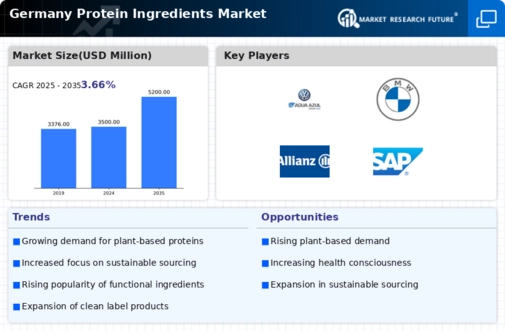The protein ingredients market in Germany exhibits a dynamic competitive landscape, characterized by a blend of innovation and strategic partnerships among key players. Major companies such as Cargill (US), BASF (DE), and Kerry Group (IE) are actively shaping the market through their distinct operational focuses. Cargill (US) emphasizes sustainability and product diversification, aiming to meet the growing consumer demand for plant-based proteins. BASF (DE), on the other hand, leverages its extensive research capabilities to innovate in protein formulations, enhancing nutritional profiles and functionality. Kerry Group (IE) is strategically positioned through its focus on flavor and nutrition, integrating protein solutions into its broader portfolio to cater to health-conscious consumers. Collectively, these strategies foster a competitive environment that prioritizes innovation and sustainability, driving growth in the sector.
Key business tactics within the protein ingredients market include localizing manufacturing and optimizing supply chains to enhance efficiency and responsiveness. The market structure appears moderately fragmented, with several players vying for market share while also collaborating through strategic alliances. This collective influence of key players not only enhances competition but also encourages the sharing of best practices and technological advancements, ultimately benefiting the entire industry.
In October 2025, Cargill (US) announced a partnership with a leading German food manufacturer to develop a new line of plant-based protein products. This collaboration is significant as it aligns with the increasing consumer shift towards plant-based diets, allowing Cargill to expand its market presence while leveraging the local expertise of its partner. Such strategic moves are likely to enhance Cargill's competitive edge in the rapidly evolving protein landscape.
In September 2025, BASF (DE) unveiled a new protein ingredient derived from fermentation technology, aimed at improving the sustainability of food production. This innovation is crucial as it not only addresses environmental concerns but also meets the rising demand for alternative protein sources. By investing in cutting-edge technology, BASF positions itself as a leader in sustainable protein solutions, potentially reshaping consumer perceptions and preferences.
In August 2025, Kerry Group (IE) launched a new range of protein-enriched snacks, targeting the growing health and wellness segment. This strategic initiative reflects Kerry's commitment to innovation and consumer trends, as it seeks to capture a larger share of the snack market. By integrating protein into convenient formats, Kerry enhances its product offerings, appealing to health-conscious consumers looking for nutritious snack options.
As of November 2025, current competitive trends in the protein ingredients market are increasingly defined by digitalization, sustainability, and the integration of artificial intelligence (AI) in production processes. Strategic alliances are becoming more prevalent, enabling companies to pool resources and expertise to drive innovation. Looking ahead, competitive differentiation is likely to evolve from traditional price-based competition to a focus on technological advancements, product innovation, and supply chain reliability. This shift underscores the importance of agility and responsiveness in meeting consumer demands, ultimately shaping the future landscape of the protein ingredients market.















Leave a Comment